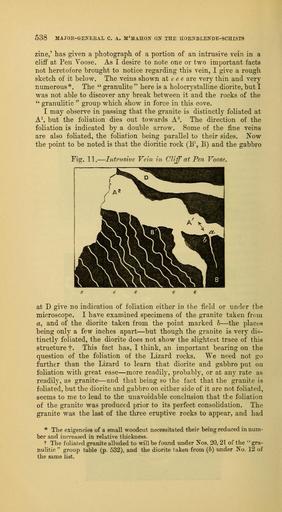MAKE A MEME
View Large Image

| View Original: | The_Quarterly_journal_of_the_Geological_Society_of_London_(13937406061).jpg (1760x3200) | |||
| Download: | Original | Medium | Small | Thumb |
| Courtesy of: | commons.wikimedia.org | More Like This | ||
| Keywords: The Quarterly journal of the Geological Society of London (13937406061).jpg 540 MAJOR-GENERAL C A M'MAHON ON THE HORNBLENDE-SCHISTS <br> dyke Similarly trie two granite dykes G 1 G 2 had probably an <br> underground connexion with each other at the time of eruption <br> This however is a mere matter of inference as owing to shingle <br> and boulders on the sea-shore not to mention the two faults their <br> onward course cannot be traced nor can they be directly connected <br> with the outcrop of the granulitic group on the foreshore <br> Fig 12 ” Diorite- and Granite-dykes intrusive in Serpentine <br> Kennack Cove <br> D f f Q s G' D <br> S serpentine ; c c gabbro ; D 1 D 2 diorite ; G 1 G 2 granite ; / / faults <br> At G 2 D 2 we see the diorite and granite running separate courses <br> through the serpentine ; at D 1 G 1 the granite has followed the <br> diorite and for a short distance they have held a common course <br> This circumstance taken alone is insufficient to justify our calling <br> D 1 G 1 an intrusive dyke of granulite <br> Mr Somervail states that at the west end of Kennack Cove the <br> dykes cutting the serpentine are seen to coalesce with the ' granu- <br> litic ' rocks forming the foreshore My last visit to the cove was <br> made at a time particularly favourable for observation It was at <br> low water at spring- tide and recent storms had swept away accumu- <br> lations of sand and shingle to such an extent that Mr Pox saw for <br> the first time rocks in situ that on every previous visit had been buried <br> six feet deep under sand I saw that the porphyritic diorite had <br> intruded profusely into ordinary diorites presumably the dioritic <br> rocks of the granulitic group and that both had been invaded <br> and injected by intrusive granite Granite-veins may be seen darting <br> about in all directions crossing and recrossing each other at every <br> angle in the porphyritic diorite of the foreshore ; but I could not <br> directly connect the diorite and granite of the foreshore with the <br> diorite and granite of the serpentine-cliffs The question then arises <br> Are they portions of the same intrusions or do the diorite and granite <br> in the cliffs represent intrusions of one period and the diorite and <br> granite in the ' ˘ granulitic group on the foreshore those of another <br> age This question will best be answered after the consideration of <br> two other sections <br> On the occasion of my last visit I was able thanks to Mr Fox's <br> able guidance to reach a very interesting spot only exposed for a <br> short time at spring-tide on the west coast about 200 yards east of 36940369 113696 51125 Page 538 Text 45 http //www biodiversitylibrary org/page/36940369 1889 Geological Society of London Biodiversity Heritage Library The Quarterly journal of the Geological Society of London v 45 1889 Geology Periodicals Smithsonian Libraries bhl page 36940369 dc identifier http //biodiversitylibrary org/page/36940369 smithsonian libraries Information field Flickr posted date ISOdate 2014-04-21 Check categories 2015 August 26 CC-BY-2 0 BioDivLibrary https //flickr com/photos/61021753 N02/13937406061 2015-08-26 05 53 27 cc-by-2 0 PD-old-70-1923 The Quarterly journal of the Geological Society of London 1889 Photos uploaded from Flickr by Fæ using a script | ||||